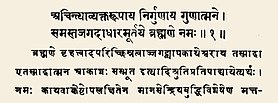سوريا سدهانتا
سُورِيَا سِدْهانتا (بالسنسكريتية: सूर्यसिद्धान्त، حرفيًّا: «أطروحة الشمس») هي أطروحة سنسكريتية في علم الفلك الهندي ذات أربعة عشر فصلاً.[1][2][3] تصف سوريا سدهانتا القواعد لحساب حركة الكواكب المختلفة والقمر بالنسبة إلى الكوكبات المختلفة، ولحساب مدارات الأجرام الفلكية المختلفة.[4][5] النص معروف من مخطوطة مصنوعة من جريد النخل التي تعود إلى القرن الخامس عشر الميلادي، والعديد من المخطوطات الأحدث.[6] تم تأليفه أو تنقيحه في حوالي 800م من نص سابق يسمى أيضًا سوريا سدهانتا.[3]
| سوريا سدهانتا | |
|---|---|
مقطع 1.1 من الأطروحة
| |
| المعلومات العامة | |
| النوع | أطروحة عن علم الفلك |
| التاريخ | بين القرن الرابع والقرن الخامس ميلادي |
| المنشأ | الهند |
| اللغة | السنسكريتية |
| تعديل مصدري - تعديل | |
ووفقًا لما ذكره أبو الريحان البيروني، عالم موسوعي مسلم، في القرن الحادي عشر، فإن نصًا يُدعى سوريا سدهانتا كُتِب من قبل الفلكي الهندي لاتا.[6][7]
يؤكد النص، وفقًا لماركاندي وسريفاتسافا، أن الأرض كروية الشكل.[2] تعامل الأرض على أنها كرة أرضية ثابتة تدور حولها الشمس - نموذج مركزية الأرض - ولا تذكر أيًا من أورانوس أو نبتون أو بلوتو،[8] لأن هذه الكواكب غير مرئية بدون التلسكوبات. يحسب قطر الأرض بـ 8000 ميل (حديثًا: 7928 ميل)،[4] قطر القمر 2400 ميل (حديثًا: حوالي 2160 ميل) والمسافة بين القمر والأرض 258000 ميل[4] (معروف الآن اختلافه: 221,500 - 252,700 ميل (356,500 - 406،700 كيلومتر)).[9] يُعرف النص ببعض المناقشات المعروفة عن الكسور الستينية والدوال المثلثية.[10][11][12]
سوريا سدهانتا هو واحد من العديد من النصوص الهندية المتعلقة بعلم الفلك. إنه يمثل نظامًا وظيفيًا قدم تنبؤات دقيقة بشكل معقول.[13][14][15] كان للنص تأثير على حسابات السنة الشمسية للتقويم الهندي القمري الشمسي.[16] تُرجم النص إلى اللغة العربية وكان له تأثير في الجغرافيا الإسلامية في العصور الوسطى.[17]
مراجع عدل
- ^ P Gangooly (1935, Editor), Translator: Ebenezzer Burgess (1930), Translation of Surya Siddhanta: A Textbook of Hindu Astronomy, University of Calcutta, page 1 نسخة محفوظة 7 أغسطس 2020 على موقع واي باك مشين.
- ^ أ ب Markanday، Sucharit؛ Srivastava، P. S. (1980). "Physical Oceanography in India: An Historical Sketch". Oceanography: The Past. Springer New York. ص. 551–561. DOI:10.1007/978-1-4613-8090-0_50. ISBN:978-1-4613-8092-4., Quote: "According to Surya Siddhanta the earth is a sphere."
- ^ أ ب Plofker، Kim (2009). Mathematics in India. Princeton University Press. ص. 71–72 with footnotes. ISBN:0-691-12067-6. مؤرشف من الأصل في 2020-08-03.
- ^ أ ب ت Richard L. Thompson (2007). The Cosmology of the Bhagavata Purana. Motilal Banarsidass. ص. 16, 76–77, 285–294. ISBN:978-81-208-1919-1. مؤرشف من الأصل في 2014-07-05.
- ^ Scott L. Montgomery؛ Alok Kumar (2015). A History of Science in World Cultures: Voices of Knowledge. Routledge. ص. 104–105. ISBN:978-1-317-43906-6. مؤرشف من الأصل في 2020-08-07.
- ^ أ ب Thompson, Richard L. (2007). The Cosmology of the Bhāgavata Purāṇa: Mysteries of the Sacred Universe (بالإنجليزية). Motilal Banarsidass. pp. 15–18. ISBN:978-81-208-1919-1. Archived from the original on 2020-07-18.
- ^ محمد محمود محمد علي (1998). الأصول الشرقية للعلم اليوناني. عين للدراسات والبحوث الانسانية والاجتماعية.
- ^ Richard L. Thompson (2004). Vedic Cosmography and Astronomy. Motilal Banarsidass. ص. 10. ISBN:978-81-208-1954-2. مؤرشف من الأصل في 2013-09-26.
- ^ Murphy، T W (1 يوليو 2013). "Lunar laser ranging: the millimeter challenge" (PDF). Reports on Progress in Physics. ج. 76 ع. 7: 2. arXiv:1309.6294. Bibcode:2013RPPh...76g6901M. DOI:10.1088/0034-4885/76/7/076901. PMID:23764926. مؤرشف من الأصل (PDF) في 2016-04-10.
- ^ Menso Folkerts, Craig G. Fraser, Jeremy John Gray, John L. Berggren, Wilbur R. Knorr (2017), Mathematics, Encyclopaedia Britannica, Quote: "(...) its Hindu inventors as discoverers of things more ingenious than those of the Greeks. Earlier, in the late 4th or early 5th century, the anonymous Hindu author of an astronomical handbook, the Surya Siddhanta, had tabulated the sine function (...)" "نسخة مؤرشفة". مؤرشف من الأصل في 2018-01-03. اطلع عليه بتاريخ 2020-08-07.
{{استشهاد ويب}}: صيانة الاستشهاد: BOT: original URL status unknown (link) - ^ John Bowman (2000). Columbia Chronologies of Asian History and Culture. Columbia University Press. ص. 596. ISBN:978-0-231-50004-3. مؤرشف من الأصل في 2020-08-07., Quote: "c. 350-400: The Surya Siddhanta, an Indian work on astronomy, now uses sexagesimal fractions. It includes references to trigonometric functions. The work is revised during succeeding centuries, taking its final form in the tenth century."
- ^ Brian Evans (2014). The Development of Mathematics Throughout the Centuries: A Brief History in a Cultural Context. Wiley. ص. 60. ISBN:978-1-118-85397-9. مؤرشف من الأصل في 2020-08-07.
- ^ David Pingree (1963), Astronomy and Astrology in India and Iran, Isis, Volume 54, Part 2, No. 176, pages 229-235 with footnotes
- ^ Duke، Dennis (2005). "The Equant in India: The Mathematical Basis of Ancient Indian Planetary Models". Archive for History of Exact Sciences. Springer Nature. ج. 59 ع. 6: 563–576. DOI:10.1007/s00407-005-0096-y.
- ^ Pingree، David (1971). "On the Greek Origin of the Indian Planetary Model Employing a Double Epicycle". Journal for the History of Astronomy. SAGE Publications. ج. 2 ع. 2: 80–85. Bibcode:1971JHA.....2...80P. DOI:10.1177/002182867100200202.
- ^ Roshen Dalal (2010). Hinduism: An Alphabetical Guide. Penguin Books. ص. 89. ISBN:978-0-14-341421-6. مؤرشف من الأصل في 2020-07-26., Quote: "The solar calendar is based on the Surya Siddhanta, a text of around 400 CE."
- ^ Canavas, Constantin (2014), "Geography and Cartography", The Oxford Encyclopedia of Philosophy, Science, and Technology in Islam (بالإنجليزية), Oxford University Press, DOI:10.1093/acref:oiso/9780199812578.001.0001/acref-9780199812578-e-68, ISBN:978-0-19-981257-8, Archived from the original on 2020-07-21, Retrieved 2020-07-19
| سوريا سدهانتا في المشاريع الشقيقة: | |
| |
